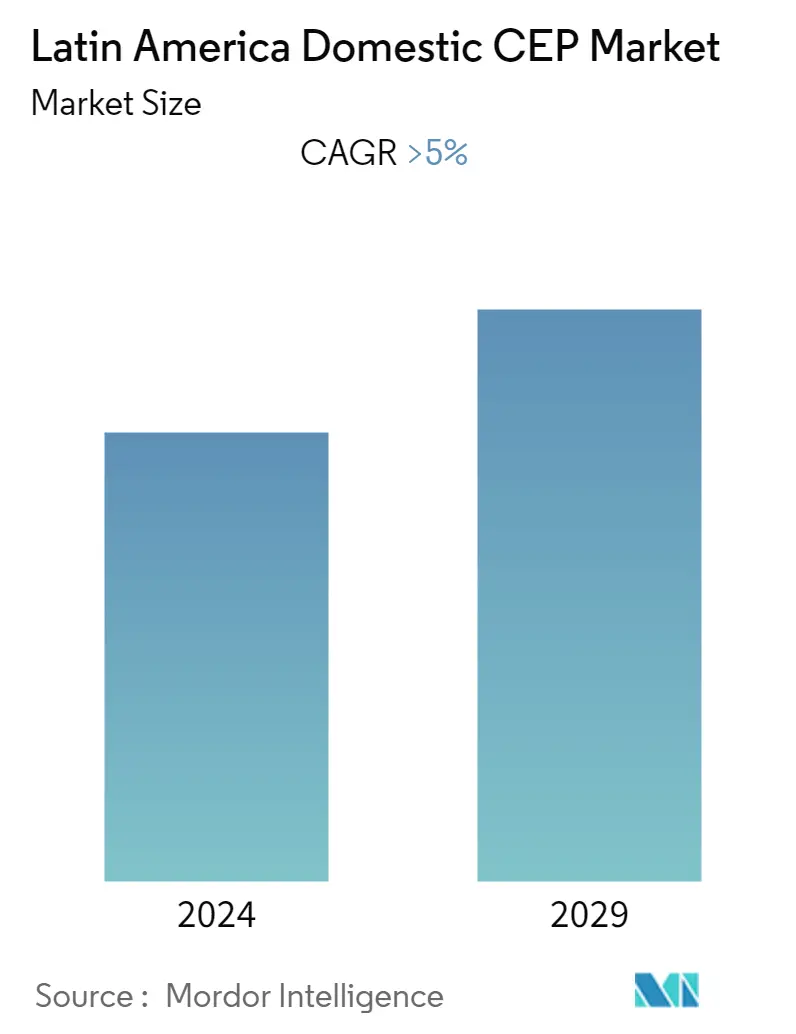Market Size of Latin America Domestic CEP Industry

| Study Period | 2020 - 2029 |
| Base Year For Estimation | 2023 |
| Forecast Data Period | 2024 - 2029 |
| Historical Data Period | 2020 - 2022 |
| CAGR | > 5.00 % |
| Market Concentration | Low |
Major Players
*Disclaimer: Major Players sorted in no particular order |
Latin America Domestic Courier, Express, and Parcel Market Analysis
The Latin American Domestic Courier, Express, and Parcel (CEP) market is estimated to witness a CAGR of more than 5% during the forecast period (2022-2027).
In the wake of the COVID-19 pandemic, digitization began to play an increasingly important role in the region. Latin Americans are making unprecedented purchases through digital means. The current wave of increasing digitization is expected to continue. With the surge in e-commerce during the pandemic, demand has suffocated the supply chain, limiting retailers' capacity to fulfill orders and restock the inventory as quickly as customers need it. Logistics services have fresh potential to acquire consumers, the first ones in the post-COVID phase, with the reviving of international commerce.
Between January and May 2021, Mexico remained the United States' top commercial partner, with 14.7% involvement and the expectation of increased imports, exports, and, potentially, commercial services, with logistics being among the most desired. In April 2021, Mexico became the United States' first business partner in terms of goods exchanges only, without including services. Mexico accounted for 14.7% of total merchandise exports and imports in the fourth month of the year, ahead of Canada (14.2%) and China (13.3%).
The e-commerce market in Mexico is strong and growing stronger, with revenue estimated to reach USD 21 billion by the end of 2021 at an annual growth rate of 3.8% and projected market volume to reach USD 24 billion by 2024. With internet penetration currently at 74% and with more than 45% of the population aged between 25-54 years old, there is scope for even more growth. The most popular category for online shoppers in Mexico is currently Electronics and Media (USD 6.42 billion), then Fashion (USD 5.2 billion).
Latin America Domestic Courier, Express, and Parcel Industry Segmentation
CEP (courier, express, and parcel) refers to a set of services that entails the delivery of various commodities and products across many places via land, air, or water. Express deliveries, in contrast to courier and parcel services, are frequently time-bound, with various high-value consignments arriving in a few days or at a pre-arranged date and time. Furthermore, the report offers a comprehensive background analysis of the Latin America Domestic CEP Market, covering the current market trends, restraints, technological updates, and detailed information on various segments and the competitive landscape of the industry. The impact of COVID-19 has also been incorporated and considered during the study.
The Latin American Domestic Courier, Express, and Parcel (CEP) Market is segmented by Business Model (Business-to-Business (B2B), Business-to-Customer (B2C), and Customer-to-Customer (C2C)), Type (E-commerce and Non-E-commerce), End User (Services, Wholesale and Retail Trade, Healthcare, Industrial Manufacturing, and Other End Users), and Country (Brazil, Mexico, Columbia, Argentina, and Rest of Latin America). The report offers market size and forecasts for the Latin America Domestic Courier, Express, and Parcel (CEP) Market in value (USD Billion) for all the above segments.
| By Business | |
| Business-to-Business (B2B) | |
| Business-to-Customer (B2C) | |
| Customer-to-Customer (C2C) |
| By Type | |
| E-commerce | |
| Non-E-commerce |
| By End User | |
| Services | |
| Wholesale and Retail Trade | |
| Healthcare | |
| Industrial Manufacturing | |
| Other End Users |
| By Country | |
| Brazil | |
| Mexico | |
| Columbia | |
| Argentina | |
| Rest of Latin America |
Latin America Domestic CEP Market Size Summary
The Latin America Domestic Courier, Express, and Parcel (CEP) market is experiencing significant growth, driven by the surge in e-commerce and increasing digitization across the region. The COVID-19 pandemic has accelerated the shift towards digital transactions, with consumers in Latin America increasingly turning to online shopping. This shift has created new opportunities for logistics services, as the demand for efficient supply chain solutions has intensified. Mexico, in particular, has emerged as a key player in the region, with strong e-commerce growth and a robust digital infrastructure. The country's strategic position as a top commercial partner with the United States further enhances its logistics potential. Brazil also stands out as a competitive market, with a thriving digital goods industry and a high rate of technology adoption among consumers.
The CEP market in Latin America is characterized by its fragmented nature, with a mix of global and local players contributing to a highly competitive landscape. Major companies such as Brazil Post, Sky Postal, Kuehne Nagel, Kerry Logistics, and DHL Express are actively expanding their operations to capitalize on the market's growth potential. Investments in new technologies and digital platforms, like DHL's Saloodo!, are being made to enhance supply chain efficiency and streamline logistics operations. The rising internet and smartphone penetration rates in the region, particularly in urban areas, are further fueling the growth of e-commerce and, consequently, the CEP market. As more consumers embrace online shopping, the demand for reliable and efficient courier, express, and parcel services is expected to continue its upward trajectory.
Latin America Domestic CEP Market Size - Table of Contents
-
1. MARKET INSIGHTS
-
1.1 Current Market Scenario
-
1.2 Technological Trends
-
1.3 Government Regulations
-
1.4 Overview of the Logistics and Warehousing Market in Latin America
-
1.5 Brief on Freight Forwarding Market in Latin America
-
1.6 Industry Supply/Value Chain Analysis
-
1.7 Spotlight on the E-commerce Sector in Latin America
-
1.8 Impact of COVID-19 on the CEP Market
-
-
2. MARKET SEGMENTATION
-
2.1 By Business
-
2.1.1 Business-to-Business (B2B)
-
2.1.2 Business-to-Customer (B2C)
-
2.1.3 Customer-to-Customer (C2C)
-
-
2.2 By Type
-
2.2.1 E-commerce
-
2.2.2 Non-E-commerce
-
-
2.3 By End User
-
2.3.1 Services
-
2.3.2 Wholesale and Retail Trade
-
2.3.3 Healthcare
-
2.3.4 Industrial Manufacturing
-
2.3.5 Other End Users
-
-
2.4 By Country
-
2.4.1 Brazil
-
2.4.2 Mexico
-
2.4.3 Columbia
-
2.4.4 Argentina
-
2.4.5 Rest of Latin America
-
-
Latin America Domestic CEP Market Size FAQs
What is the current Latin America Domestic CEP Market size?
The Latin America Domestic CEP Market is projected to register a CAGR of greater than 5% during the forecast period (2024-2029)
Who are the key players in Latin America Domestic CEP Market?
Brazil Post, Sky Postal, Kuehne Nagel, Kerry Logistics and DHL Express are the major companies operating in the Latin America Domestic CEP Market.

